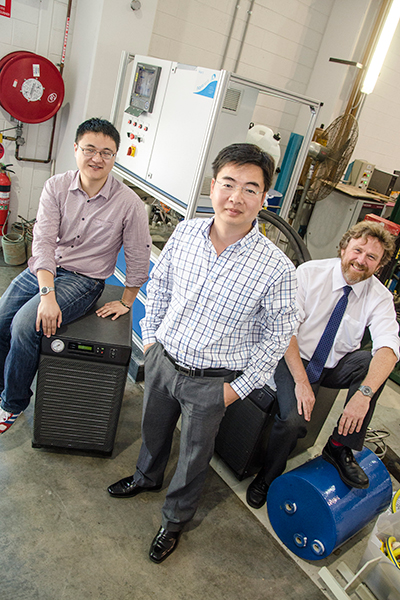February 4, 2014
Capturing phosphorus from sewage waste solves dual problem
A team of researchers from the University of Wollongong has led the way in overcoming a demanding environmental challenge by capturing potentially harmful phosphorus from sewage waste and delivering clean water.
If released into natural waterways, phosphates can cause harmful algal blooms and low-oxygen conditions that can threaten to kill fish. Meanwhile, there is a high demand for phosphorous for use as an agricultural fertilizer.
The UOW research-led team has now designed a system that could help solve both of these problems. It captures phosphorus from sewage waste and delivers clean water using a combined osmosis-distillation process.
Conventional methods for extracting phosphorus from wastewater use chemicals to precipitate a mineral called struvite from the water. [Struvite contains phosphorus, ammonium, and magnesium, and is a useful slow-release fertilizer] making it a time-consuming and costly process.
To bring down the costs of struvite recovery from wastewater, Associate Professor Long Nghiem of UOW’s School of Civil, Mining and Environmental Engineering and his colleagues decided to modify a system they recently designed for harvesting freshwater from sewage waste using forward osmosis and membrane distillation.
By tweaking this method, they have reduced the amount of chemicals required to mine struvite from wastewater.
“We need to develop technology to convert every wastewater treatment plant into a phosphorus quarry. This is the only way to ensure that future generations will never run out of phosphorus,” Professor Nghiem said.
Chemical and Engineering News reported that the team’s prototype system has two parts that work in tandem, one for harvesting struvite and the other for recovering freshwater. The first part is a two-sided cell divided by a semipermeable membrane with concentrated wastewater on one side and a highly concentrated salt solution on the other. Osmosis drives water across the membrane from the more dilute wastewater side to the saltier “draw” solution, increasing the concentration of phosphorus and ammonium in the wastewater.
The team must overcome some hurdles before their system can be implemented on a commercial scale. In particular, they must address the fouling of the system’s semipermeable membrane, which must be frequently flushed with deionized water to maintain maximum flow rates.
Professor Nghiem’s team is researching ways to limit this fouling and hopes to test the system on a pilot scale within the next few years.
The research team comprises UOW PhD candidate Ming Xie, Ming’s Principal Supervisor, Associate Professor Long Nghiem of UOW’s School of Civil, Mining and Environmental Engineering; Ming’s Co-supervisor, Professor Will Price (Executive Director of UOW’s Australian Institute of Innovative Materials Research Facility); and Professor Menachem Elimelech from Yale University in the US.
Details of their research have been published in two papers in the American Chemical Society & Environmental Science and Technology Letters -
A Forward Osmosis–Membrane Distillation Hybrid Process for Direct Sewer Mining: System Performance and Limitations
Toward Resource Recovery from Wastewater: Extraction of Phosphorus from Digested Sludge Using a Hybrid Forward Osmosis–Membrane Distillation Process
